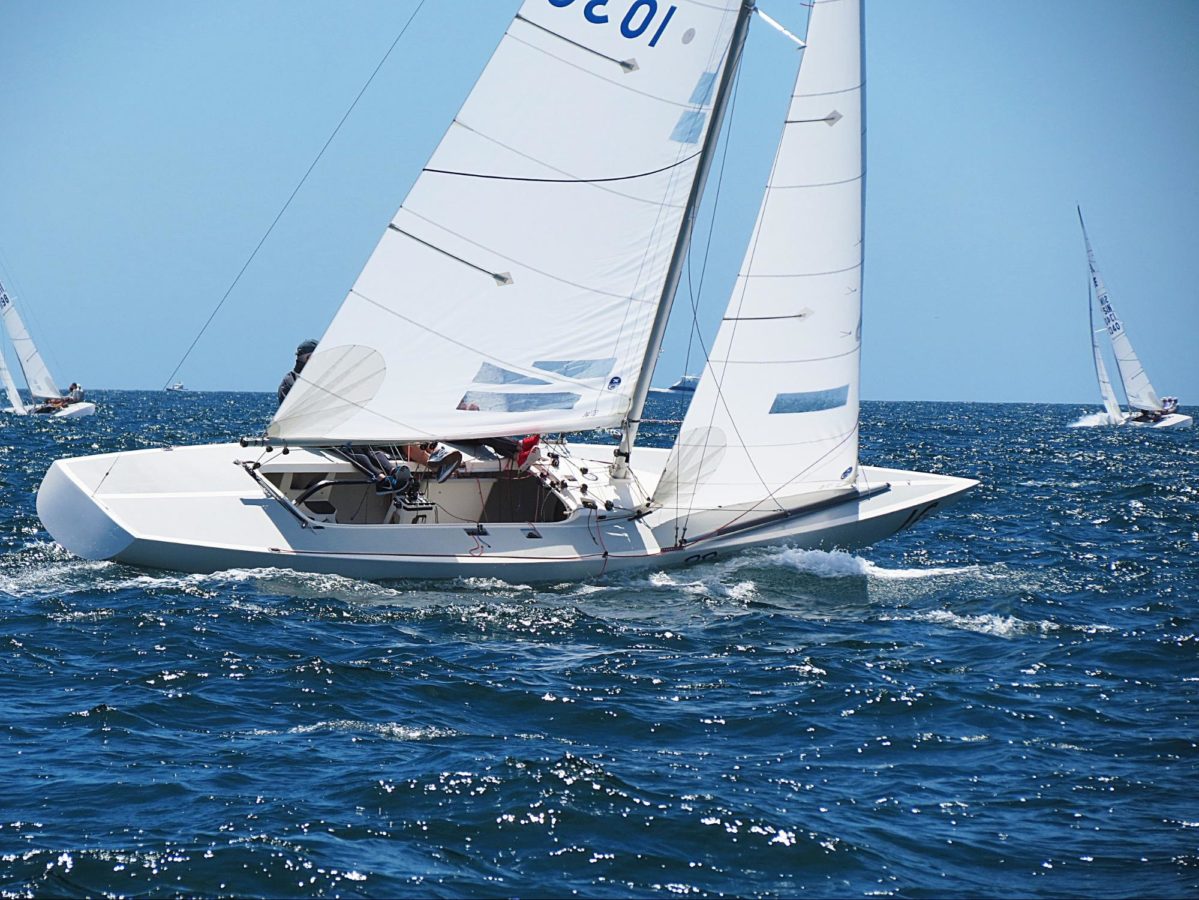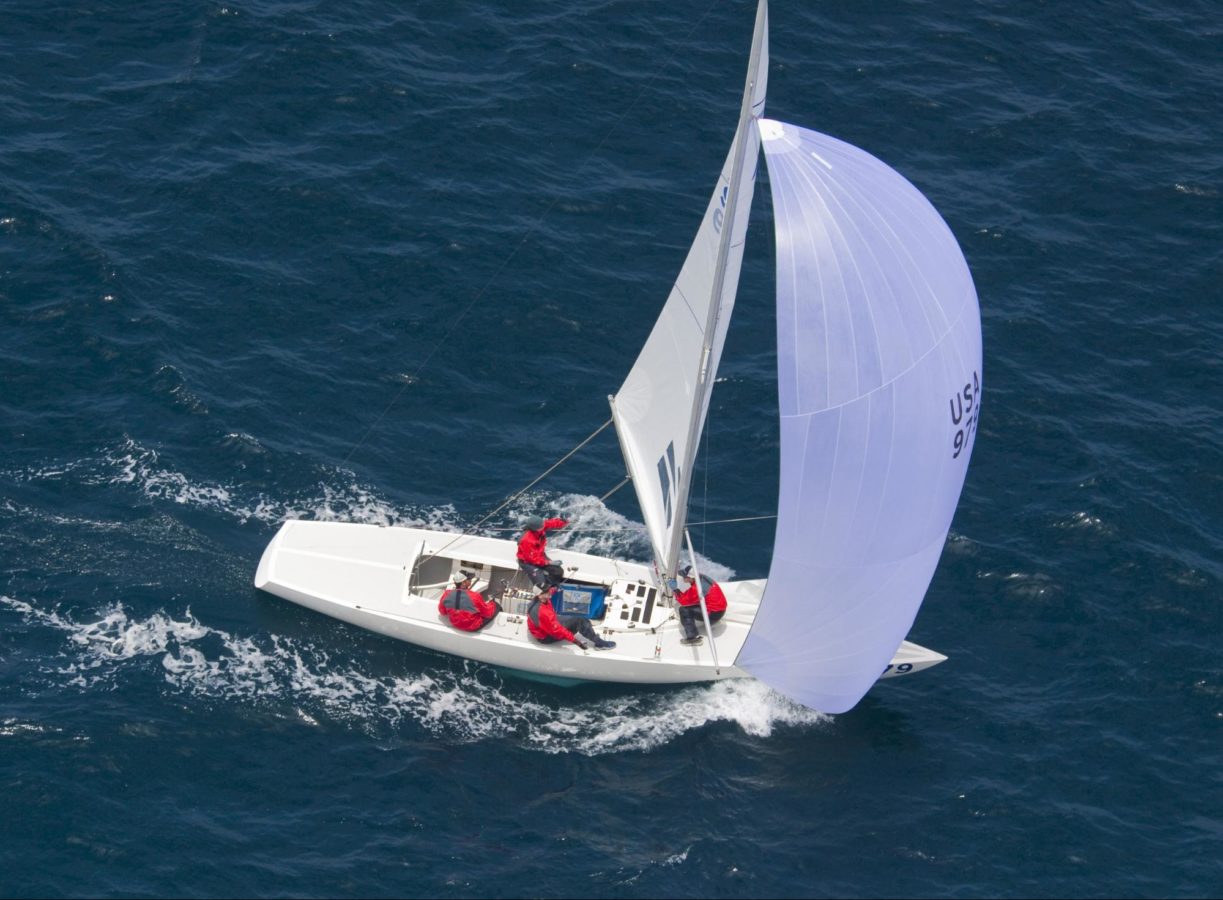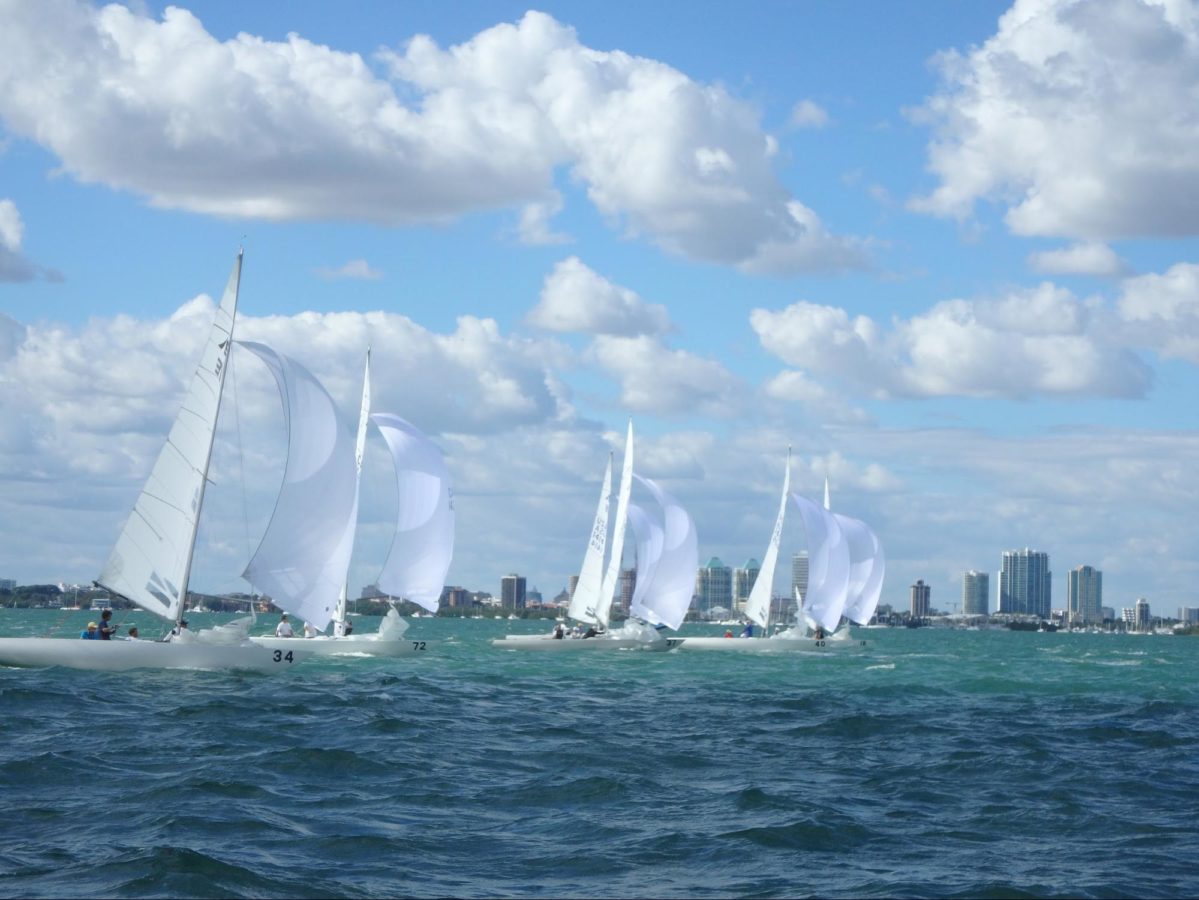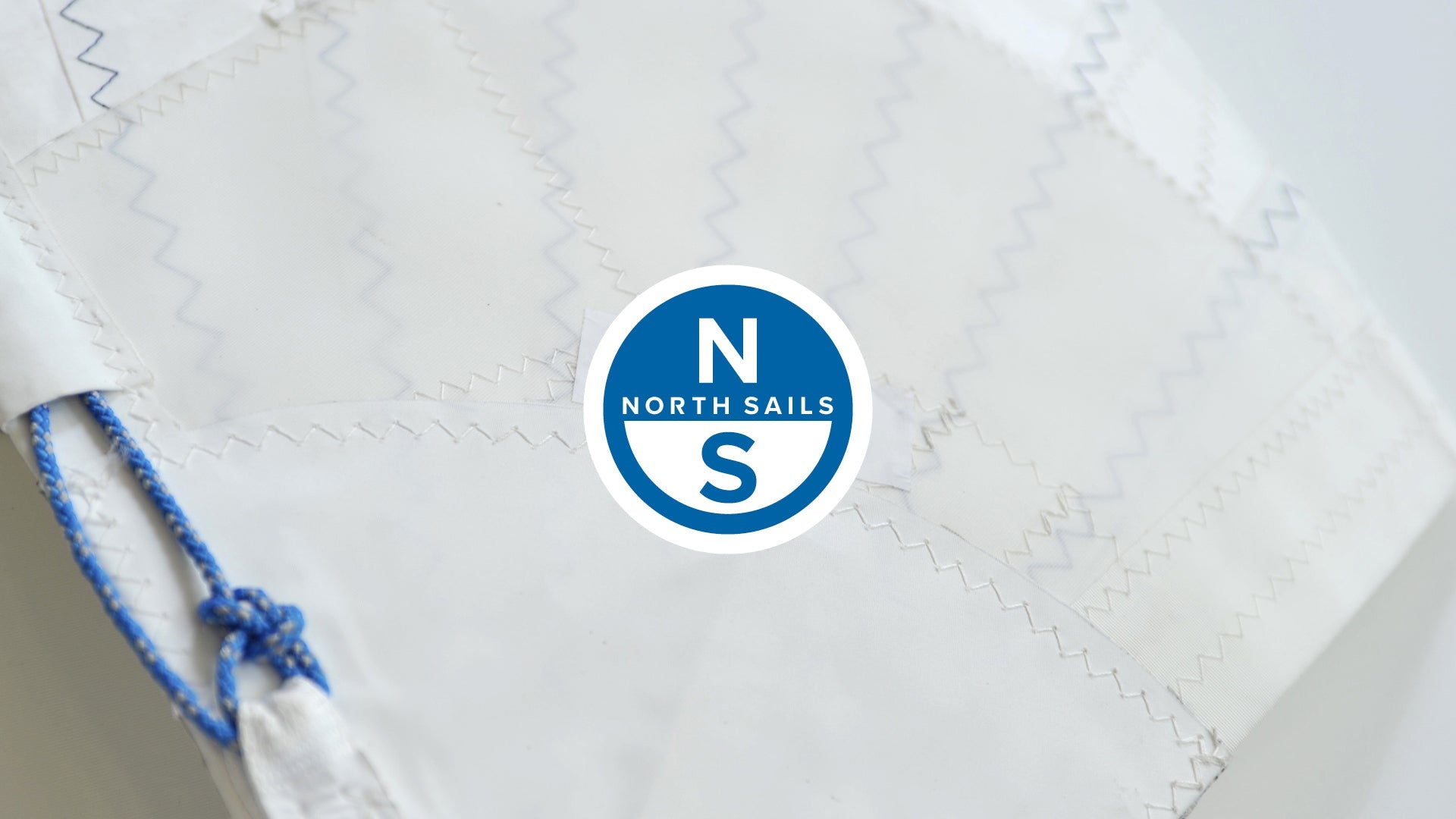ETCHELLS SPEED GUIDE
North Sails expert Noel "Nitro" Drennan answers your Etchells speed and boathandling questions.
Who sails in the Etchells Class?
Etchells one-design keelboats have been around since 1966 and provide one-design racing at its highest level from Australia to the U.S. to Europe. The class culture is focused on providing excellent racing against both pros and amateurs, including many of the same pros found aboard America’s Cup and grand prix boats. At the elite end, coaching is common; the amateurs prepare well enough to beat the pros, which means the pros also need to prepare well if they want to win. The Etchells has many long-term class sailors, a testament to the class and the quality of racing it provides.
What is the ideal Etchells crew size?
The crew weight limit is 285 kg. (629 lbs.), and you can either race with three or four crew members. This gives a wide variety of crew options. Ideally, your crew size is close to the maximum class weight and they are able to hike hard. That being said, many crews don’t hike hard all day long and still perform well through excellent steering and sail trim, which is the most important factor in class success.
What’s the biggest difference between sailing with three or four crew members?
While there’s more space on boats with only three, larger crew, there are more hands with four for maneuvers. Crew communications can be different, too. Many of the four-up crews have the luxury of a designated tactician, whereas three-up crews have to divide the sailing roles and tactical decisions between them.
Where can you buy an Etchells?
Fortunately, the Etchells has three world-class boat builders on three continents. Second-hand boats are also readily available (see class website), ranging from $3,500 US for a starter boat to $60,000-90,000 for a boat in tip-top race condition.
How do you transport an Etchells?
An Etchells is relatively easy to tow. Most SUVs can pull the all-up boat-and-trailer weight of 2,300 kg (5,000 lbs.). Our top tip is to have your mast lifters sorted out before the regatta to speed the pack-up. We use a single-post lifting pole, as the aluminium masts are quite light.
What kind of inventory does North recommend?
North Sails has well-proven off-the-shelf sail models linked to a current tuning guide, so getting up to speed is easy. That being said, we are always looking for your next speed edge. The current North inventory has options to cover the wide variety of wind and sea states found at regattas all over the world. A few of our sail models have been around for years; the GM series of headsails has been a class favorite for over 25 years and is still winning races today. 
Etchells Tuning
What are the basics of tuning the Etchells rig?
The North Sails tuning guide helps you set up your mast and rig properly. It covers rig set-up including spreaders, mast step, mast rake, and some key jib-trim pointers. It also describes the base shroud tension settings we recommend and the changes you need to make as wind speed rises and falls. A key step during the set-up is to measure the mast base relative to the mast collar using the method described in the tuning guide, marking the aft deck 12 feet (3655mm) from the aft part of the mast collar and measuring the mast step from that position at 12 feet 6 inches (3830mm). The boats are close to identical, but this exact mast-port-to-mast-step measurement relationship is key to each boat.
What are the “base” shroud settings for the Etchells?
We recommend a base shroud setting for 9 to 11 knots as per the tuning guide. From there, it is an easy process to power up by loosening both upper and lower shrouds below 9 knots, or to depower when the wind is above 11 knots by tightening the shrouds. Recently the class has evolved to adjusting the lower shrouds through a larger range than the upper shrouds. On our boat, I usually only adjust my upper shrouds a total of five turns (two turns below base or three turns tighter than base). I adjust my lower shrouds 11 turns in total—four turns below base and seven turns tighter as it gets windy and we get overpowered. 
📸 Bob Grieser
Upwind Trim Guidelines
Where does each person sit when sailing upwind?
Upwind, fore-and-aft crew positions are fairly stationary but nudging slightly forward in light air and slightly aft when windy and/or in waves.
What are the keys to Etchells sail trim?
When sailing upwind, we recommend focusing on helm balance as much as the actual sectional shape of the sails. In no boat more so than the Etchells do you trim the entire sail package together, rather than set up the mainsail and headsail individually. If the helm is balanced, the boat will respond. Note that even though it is smaller, the headsail usually provides the majority of the drive force, so it deserves your full attention.
What are the key controls for changing gears when wind and sea state change?
The mast lever has been a big improvement, as it definitely makes quick mast-bend changes easy. Now it’s possible to maintain a nice mainsail luff curve while adding forestay sag to suit your light-air headsail.
When do you change from a lighter-air jib to one for windier conditions?
The most common light-air jib is the LM2L, which is designed for up to 12 knots—although we’ve seen some crews use it successfully in much higher windspeeds. The best option in 12 to 18 knots is the LM2H. The still-popular GM jib is favored by many sailors as an all-purpose sail from 10 to 25 knots. 
📸 Bob Grieser
Downwind Trim Guidelines
What are the keys to downwind speed in the Etchells?
Downwind in the Etchells rewards both deep-angled tactical racing and strong surfing techniques. It is usually a pretty good workout downwind, pumping the spinnaker sheets and mainsheet, while moving body weight to help catch waves.
In lighter air, what are your top tips for downwind speed?
It’s very important to rake your mast forward in light air enough for a small inversion in the middle of the mast. Also, if there is any chop downwind, I like to keep my crew weight as low as possible, sitting or crouching on the cockpit floor.
Where does each crew member sit when sailing downwind?
Downwind in light air, moving crew weight forward is a good thing. There have been quite a few times we have seen teams gain on a run when a crewmember goes up on the foredeck to change jibs. We recommend keeping crew weight forward until the bow starts immersing into the back of the next wave. 
Boathandling Guidelines
Any recommendations for starting in an Etchells?
As in all competitive classes, starting is paramount—and probably even more important in the Etchells with its long, relatively heavy, metre-style hull. If you’re not up to best speed at the gun, you definitely fall off the front row. Typically, if you start well and can hold your lane for three minutes, you are going to be up there at the first upwind mark.
How do you tack the Etchells?
Good roll tacking and jibing in light air pays big dividends. A long slow tack gives you the chance to gain many meters to windward, as the boats will carry their way directly upwind.
What are some tips for good light or heavy air jibes?
When it’s windy, especially in big waves, I like to jibe the mainsail first, keeping the crew in the cockpit, and then jibe the spinnaker pole once the boat is stable. We often notice that the four-crew boats can gybe better than three-member crews. In light air, they can roll the boats harder, and when it’s windy, they split the crew roles more effectively.
How do you make a fast spinnaker set on the Etchells?
Here’s a good routine that will help the forward crew get the spinnaker up and drawing in good order: 1) get organized on the offset leg; 2) ease the ram lever; 3) drop the mainsail traveler; 4) pre-set the spinnaker sheet to its downwind mark; 5) bear away to a downwind angle at the offset mark, so the spinnaker trimmer does not have to sheet on hard once the sail is drawing.
What is the key to a good spinnaker takedown?
Spinnaker douse systems with hard boxes have made takedowns a much easier process. The boxes are usually lightweight fiberglass or sailcloth on a frame that is retracted by shockcord to the side of the hull. The takedown is a manual system, but it works surprisingly well for either a windward or leeward drop. If it’s really windy, a leeward drop is safer, ideally on a starboard tack approach to the leeward mark.
How easily does the Etchells broach?
The Etchells are difficult to broach but they do tend to roll to windward in windy downwind conditions. When it’s really windy, we recommend easing the pole forward slightly and putting the bow up a little so you can keep all the crew on the windward side. This definitely feels a lot more in control, especially when the bow begins burying into the wave in front.
What boathandling drills do you suggest?
Always practice time-and-distance runs to be at your best speed at the starting gun. Set up practice starts with a goal of never having to bear away or run down the line as the gun fires. Drone footage of practice or race starts is an awesome way to review your starting technique. You’ll learn a lot from simply reviewing your turn rates. The long, slow meter-boat type hull loses minimal boatspeed, which can be very efficient in your pre-start maneuvering. I try to keep my turn rate long to maintain as much boat speed possible; in light air this can take up to 25 seconds per circle. 



























